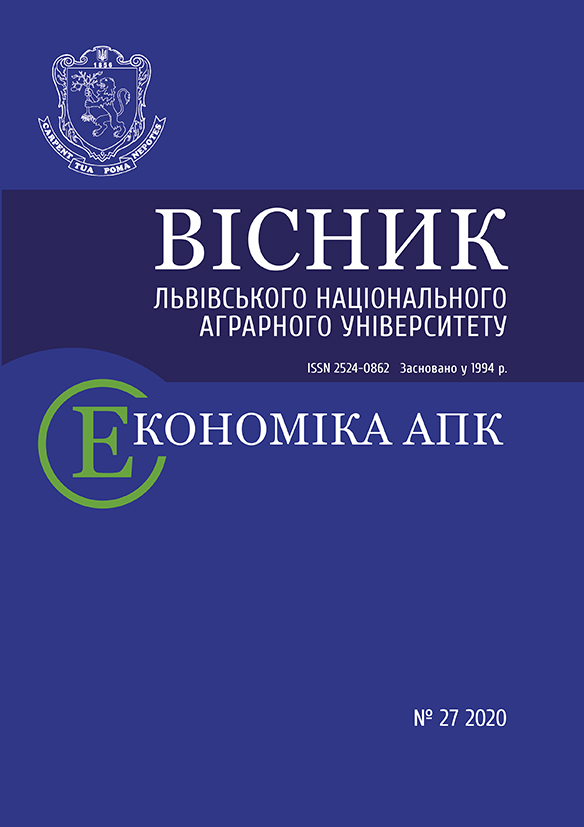Visnyk LNAU: Architecture and Farm Building 2021 №22: 154-162
TO THE ISSUE OF MONITORING AGRICULTURAL ACTIVITY IN THE COASTAL ZONE OF KREMENCHUK RESERVOIR
S. Lashko, Candidate of Geological Sciences
ORCID ID: 0000-0001-9146-5687
N. Halchenko, Candidate of Biological Sciences
ORCID ID: 0000-0003-2659-177X
V. Kozar, Candidate of Geological Sciences
ORCID ID: 0000-0003-4084-3507
O. Klyuka, Candidate of Geological Sciences
ORCID ID: 0000-0002-9250-1157
Kremenchuk Mykhailo Ostrohradskyi National University
https://doi.org/10.31734/architecture2021.22.154
Annotation
The high speed of degradation of the right coast of Kremenchuk reservoir in its lower part, the constant displacement of the coastline of the reservoir in the direction of land and the need to adjust the coastal protective zone, which is installed on the banks of reservoirs, is analyzed. The legal and spatial features of establishing a coastal protective zone of reservoirs are outlined in accordance with the Ukrainian legislation, as well as the peculiarities of limiting the regime of economic activity within the coastal protective zones. The legality of the protection of the coastal protective zones of Kremenchuk reservoir from the conditional coast line, which corresponds to the normal level of water reservoirs, is substantiated.
The application of the Ukrainian legislation norms on the width of coastal protective zones requires establishment of coastal slopes steepness. To justify the width of the coastal protective zone, it is recommended to use hypsometry and GPS functions on Google Earth Pro interactive maps. The relevant methodological approaches are shown on an example of a portion of the coast, located on the northern outskirts of the village Stetsivka Chyhyryn territorial community of Cherkasy district. In particular, by the images of Google Earth on a specific hypsometry route, one can determine the coast boundary (the inner boundary of the coastal protective zone), which corresponds to the normal water level 81 m, the external boundary of the coastal protective zone of 100 m, the average slope of the coast within this zone and the external boundary of the coastal protective zone in 200 m (due to the steep coast of the reservoir more than three degrees). The geographic coordinates of geometric constructions are identified. In a specific arable plot, the boundaries of its territory with a limited regime of economic activity are outlined. The average slope of the coast on the route of the study is: within the coastal protective zone in width 100 m – 10.7 % or 6.11 degrees; within the coastal protective zone in width 200 m – 8.7% or 4.97 degrees. At the same time, on separate segments of the route (coastal part of the land), the coastal slope is 16.3–17.0 % or 9.26–9.65 degrees. The limited regime of economic activity is subjected to a strip of problematic agricultural plot in a width of 52 m.
Key words
reservoir, coast, protective zone, arable, monitoring
Link
- Bahmet O. B. Influence of the Dnipro cascade of reservoirs on the current geomorphogenesis of adjoining territories. Bulletin of V. N. Karazin Kharkiv National University. Еcоlogy. 2017. Iss. 17. P. 55–62.
- Dubniak S. S. Ecohydromorphological approach to the justification of coast-protection on the Dnipro reservoirs. Hydrology, hydro chemistry and hydro ecology. 2015. Iss. 3 (38). P. 16–24.
- Dubniak S. S. Ecohydromorphological approaches to identification both delimitation of shallow and coastal zones of large flat reservoirs. Hydrology, hydro chemistry and hydro ecology.. 2010. Iss. 2 (19). P. 29–43.
- Halchenko N., Ilchenko V., Mudrak O., Mudrak G. The structuring of the lands nature reserve fund Central forest-steppe of Ukraine. International Journal of Engineering & Technology. 2018. Vol. 7 (4.8). Р. 549–553.
- Land Code of Ukraine dated 25.10.2001 No. 2768-ІІІ. URL: https://zakon.rada.gov.ua/laws/show/2768-14#Text (Accessed June 10, 2021).
- Lashko S. P., Dryga A. S. Actual condition and hypsometry of the south-western coast of the Kremenchuk reservoir. Monitoring of Geological Processes and Ecological Condition of the Environment: Conference Proceedings, XIV International Scientific Conference, November 10–13, 2020 / European Association of Geoscientists & Engineers. Kyiv, 2020. Р. 1–5. doi: 10.3997/2214-4609.202056015.
- Lashko S. P., Dryga A. S. Problems of land organization of the coastal zone of Kremenchuk reservoir. Modern problems and actual directions of development of land management and cadaster: monograph / edited by S. V. Bogomazov, A. I. Chursin, A. A. Galiullin. Penza: RIO PGAU, 2019. P. 26–42.
- Order of determination of the sizes and boundaries of water reservoirs and the regime of economic activity in them: Resolution of the Cabinet of Ministers of Ukraine dated 08.05.1996 No. 486. URL: https://zakon.rada.gov.ua/laws/show/486-96-%D0%BF#Text (Accessed June 10, 2021).
- Shelkovska I. M. Analysis of the use of land resources of Kremenchuk water basin coastal areas. Bulletin of Kremenchuk National University named after Mykhailo Ostrohradskyi. 2015. Iss. 2 (91). P. 170–175.
- Shevchuk S. A., Vyshnevskyi V. I., Shevchenko I. A. Use of DDE data to establish the environmental state of Dnipro reservoirs. Works of the central geo-physical observatory. 2014. Iss. 10 (24). P. 72–78.
- Vyshnevskyi V. I. Dnipro reservoirs and problems of their use. Hydro energetics of Ukraine. 2018. No. 3–4. P. 18–23.
- Water Code of Ukraine dated 06.06.1995 No. 213/95-BP. URL: https://zakon.rada.gov.ua/laws/show/213/95-%D0%B2%D1%80#Text (Accessed June 10, 2021).



